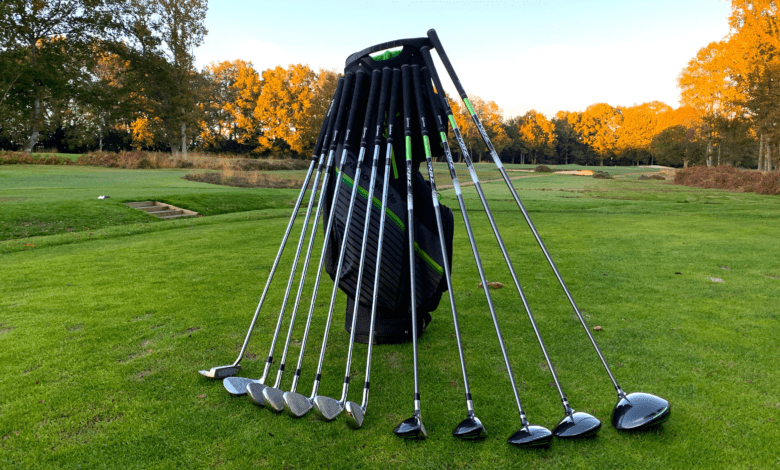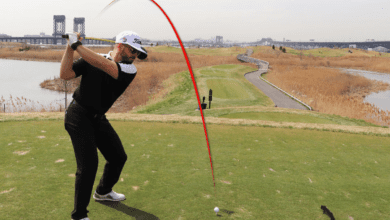How to Choose the Perfect Golf Clubs: Factors to Consider

Choosing the right golf clubs is essential for any golfer, as they directly impact your performance and enjoyment on the course. With so many options available, it can be overwhelming to make a decision. In this article, we will guide you through the factors to consider when choosing the perfect golf clubs.
1. Skill Level
Consider your skill level when selecting golf clubs. Beginners may benefit from more forgiving and game improvement clubs, which offer a larger sweet spot and are easier to hit. Intermediate and advanced players may prefer clubs that provide more control and workability. Assess your skill level honestly and choose clubs that match your current abilities.
2. Club Type
Golf clubs are commonly classified into three sorts: woods, irons, and wedges. Woods are intended for remote chances from the tee or fairway, irons are flexible for different distances and shots, and wedges are utilized for short proximity shots and specific shots around the green. Figure out which kind of club you really want in light of the particular shots you experience during your rounds.
3. Shaft Material
Golf club shafts can be made of steel or graphite. Steel shafts are by and large more sturdy and give better control, making them reasonable for players who favor a more reliable and controlled swing. Graphite shafts are lighter and proposition greater adaptability, giving sped up and separate. Consider your swing velocity, inclinations, and state of being while picking either steel and graphite shafts.
4. Shaft Flex
Shaft flex refers to the amount of bending in the shaft during the swing. The flex of the shaft affects the trajectory and accuracy of your shots. Choose a shaft flex that suits your swing speed and tempo. Generally, slower swing speeds benefit from a more flexible shaft (such as regular or senior flex), while faster swing speeds benefit from a stiffer shaft (such as stiff or extra stiff flex).
5. Clubhead Design
Clubhead configuration assumes a part in pardoning and playability. Fledglings and high-handicap players might incline toward clubs with a bigger clubhead size, as they offer a bigger perfect balance and are really lenient on helter-skelter hits. Low-handicap players might favor clubs with a more modest clubhead size, as they give greater functionality and control. Consider your ability level and wanted degree of pardoning while picking the clubhead plan.
6. Clubhead Loft
The loft of the clubhead affects the trajectory and distance of your shots. Higher lofted clubs, such as wedges, provide more height and shorter distances, while lower lofted clubs, such as drivers and woods, provide lower trajectories and longer distances. Assess the specific distance gaps you need to cover and choose clubs with appropriate loft angles to ensure consistent distance spacing in your bag.
7. Club Length
Club length is an important factor in achieving proper posture and swing mechanics. Taller players generally require longer clubs, while shorter players may benefit from shorter clubs. Consider getting a club fitting or consulting with a professional to determine the appropriate club length for your height and swing characteristics.
8. Grip Size
The grip size of your clubs can affect your comfort and control. Grips that are too small may result in excessive hand action, while grips that are too large may restrict your hand movement. Find a grip size that allows you to grip the club comfortably with a light but secure hold. Consider experimenting with different grip sizes to find the one that suits you best.
9. Budget
Set a budget for your golf clubs. Prices can vary widely depending on the brand, materials, and technology. Determine your budget range and explore different options within that range. Keep in mind that investing in quality clubs can offer long-term benefits, but there are also affordable options available for those on a tighter budget.
10. Try Before You Buy
“Attempt before you purchase” alludes to the act of testing or evaluating an item prior to making a buy. With regards to picking golf clubs, it implies actually hitting shots with various clubs to survey their presentation, feel, and appropriateness for your game.
Attempting golf clubs prior to getting them is significant on the grounds that it permits you to encounter firsthand the way in which they perform and how they feel in your grasp. Every golf player has a special swing and playing style, and what functions admirably for one individual may not fill in as successfully for another. By evaluating clubs, you can decide whether they line up with your swing mechanics, give the ideal distance and precision, and feel open to during the swing.

Visiting a golf store or a playing golf office that offers club demos or club fitting administrations is an incredible method for attempting various clubs. They might have assigned hitting sounds or driving reaches where you can hit shots with the clubs you are keen on. This involved experience permits you to survey factors like the club’s pardoning on askew hits, the sound and input upon influence, and your general certainty and solace level with the club.
Attempting golf clubs prior to purchasing additionally offers you the chance to look at changed brands, models, and details. You can see which clubs perform better for your particular requirements and inclinations. It’s prescribed to attempt different clubs inside a similar class (e.g., drivers, irons, wedges) to track down the ones that suit your game best.
At last, attempting golf clubs prior to getting them assists you with settling on a more educated choice. It guarantees that you select clubs that upgrade your presentation, feel great in your grasp, and line up with your swing qualities. Getting some margin to evaluate various clubs can extraordinarily add to your general fulfillment and delight in the game.
FAQs:
1. Should I buy a complete set of golf clubs or individual clubs? It depends on your needs and preferences. A complete set is convenient and ensures that all your clubs are consistent in terms of brand and specifications. However, if you have specific preferences or want to customize your club selection, buying individual clubs allows for more flexibility.
2. How often should I replace my golf clubs? The lifespan of golf clubs can vary depending on usage and maintenance. Generally, golfers replace their clubs every 3-5 years, but it ultimately depends on factors such as wear, technology advancements, and changes in your game.
3. Is it necessary to get a club fitting? A club fitting can greatly benefit your game. It involves analyzing your swing characteristics, body measurements, and preferences to determine the best specifications for your clubs. A professional club fitting can help optimize your performance and ensure that your clubs are tailored to your unique needs.
4. Can I use different brands of clubs in my set? Yes, you can mix and match clubs from different brands in your set. Golfers often do this to find the best-performing clubs for each specific type. However, it’s important to ensure that the clubs you choose work well together in terms of shaft flex, weight, and feel.
5. How do I know if a club feels right for me? The best way to determine if a club feels right for you is to try it out. Visit a golf store or facility that offers demos or club fitting services. Hit shots with the club and pay attention to how it feels in your hands, the sound it makes on impact, and the feedback you receive. Trust your instincts and choose a club that feels comfortable and suits your swing.
Conclusion
Picking the ideal golf clubs requires cautious thought of your expertise level, club types, shaft material, shaft flex, clubhead plan, clubhead space, club length, hold size, and financial plan. Get some margin to research, test, and talk with experts when essential. By taking into account these elements and finding clubs that suit your game, you can upgrade your presentation and satisfaction on the green.





